Affiliate disclosure: This post may contain affiliate links. Please see our Privacy Policy.
Plum jam tastes like summer and those sun-kissed fruits will remind you of warmer days when you’re eating this tasty plum preserve on cold winter days. It’s easy to make with just two ingredients, just plums, and sugar, no added pectin required.
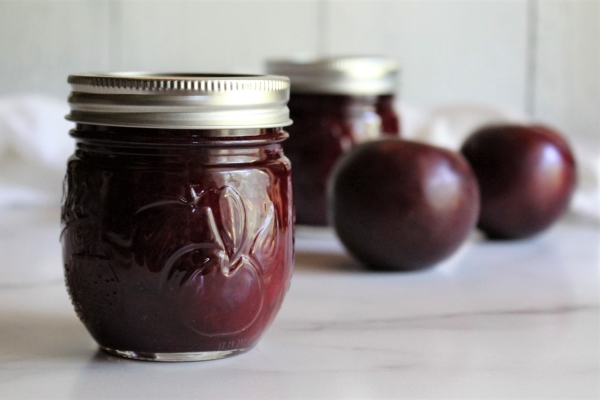
We grow bucket loads up plums every year here on our Vermont homestead, of every color, flavor, shape, and variety. The trees grow fast and begin bearing fruit in just a few years, thriving in our moist shady woodland soils. Last count, we had around 30 trees and it’s rare we see a year that we’re not buried in plums.
Rare I say, but it does happen. Combine late frosts, with spring drought and a bumper crop of squirrels and you’ve got a recipe for a plum free summer.
We had just a handful of plums on the trees, and all of those went to fresh eating within seconds of picking.
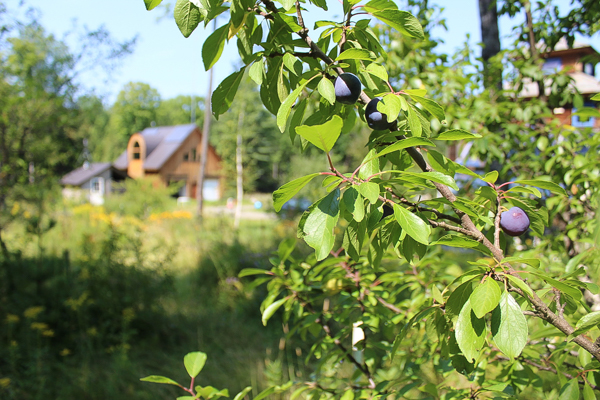
Crop failure or not, there’s no way I’m going a year without homemade plum jam. I broke down and bought a few bags of supermarket plums this year, which gave me a chance to test out my tried and true plum jam recipe with those gigantic, juice-filled California plums on the supermarket shelves.
The result? Absolutely delicious.
Though I’m partial to our own Vermont plums, this plum jam recipe comes together and gels beautifully with just plums and sugar (no commercial pectin needed).
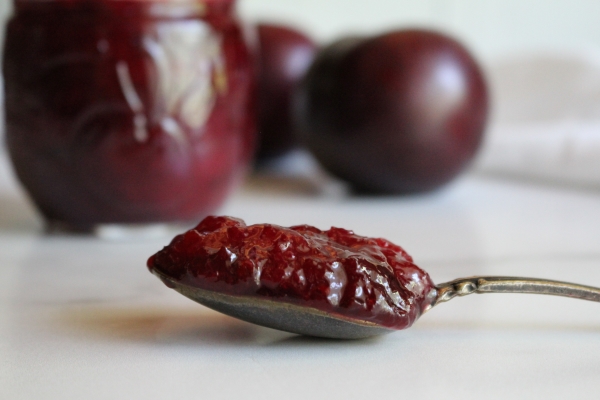
Types of Plums for Plum Jam
It’s important to note that the type of plums you use will really impact that flavor of your final jam. That’s true to some extent with any fruit, but I imagine most people couldn’t really pick out different types of strawberry in a blind jam taste test.
Plums, on the other hand, make dramatically different jams based on the variety. Sweet and juicy purple plums make a classic plum jam that’s familiar to most people, but that doesn’t mean that other types won’t work.
Taste the plums first, and if you like the fruit, chances are they’ll make a darn good jam (and taste an awful lot like their fresh version).
That said, don’t shy away from abrasive plum varieties like tart, tannin-rich damson plums. Once you add sugar, those previously unpleasant plums become a rich and complex jam. Wild plums also make an excellent plum jam.
On the other hand, if you really like a mild jam, choose golden fleshed plums like greengages, which produce a plum jam that tastes almost like apricot jam.
I’ve yet to make a plum jam that I didn’t like, and they all have their merits. Regardless of the variety you choose, this plum jam recipe will suit you just fine. If you have extremely sweet fruit, you can reduce the sugar if you choose, and bitter or astringent plums might call for more based on your tastes. It’s up to your tastes, and I generally stick to this recipe regardless of the type of plum.
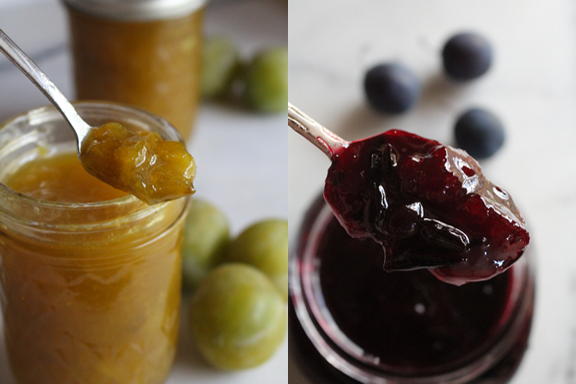
How to Make Plum Jam
For this homemade plum jam recipe, I start with about 9 cups of chopped plums (about 3lbs prepared). I pit the plums, but I don’t skin them.
The plum skins add amazing color to the finished jam, and believe it or not, that’s where a lot of the flavor is. If you don’t like the skins in your finished jam, there are a couple of things you can do:
- Dice the plum pieces very small. That’ll mean smaller pieces of skin in the finished fruit, and 1/2 inch to 1-inch pieces makes for barely noticeable plum skins.
- Puree the pitted plums before starting. The skins will be just a part of the jam as a whole, and you won’t be able to notice them at all in the texture of the finished jam. This creates something different, a bit more like plum butter (but without all the slow cooking & complex flavors that result).
- Simply make plum jelly instead. All the solids are filtered out through a jelly bag and you get a perfectly smooth jelly instead. There’s still no need to add pectin at all, and you can still make it with just 2 ingredients (strained plum juice and sugar).
For my tastes? I like the skins, and leave them just as they are.
All I do is pit and slice the plums before making plum jam.
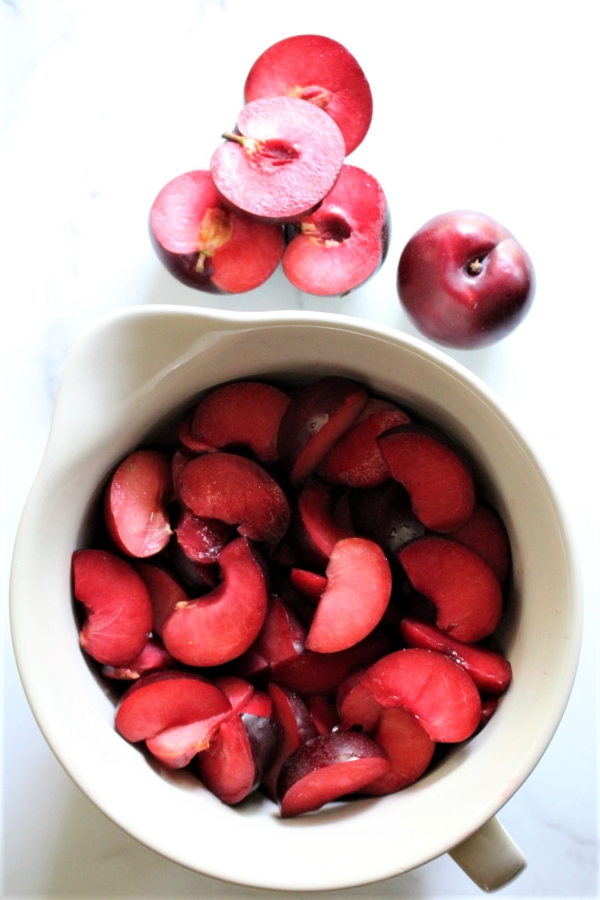
After preparing the fruit, you’ll need to decide on how much sugar to add. I’m going to give you my go-to recipe for plum jam, but there’s actually quite a bit of wiggle room if you’d like to use either more or less sugar.
For 9 cups chopped plums (3lbs prepared, 3 1/2 lbs with pits), I add 3 cups sugar (or 1 1/2 lbs). That results in a fruit to sugar ratio of 2:1 by weight or 3:1 ratio by volume.
Most recipes recommend 2:1 by volume, resulting in quite a bit more sugar. Some even go as high as 1:1, especially for Damson plum jam recipes where the plums are quite tart.
I think most plums are plenty sweet and don’t need to be hidden behind all that sugar. For the best flavor, I’d suggest using half as much sugar (by weight) as fruit. That’ll still get you a sweet plum jam, and a good yield, without hiding the spectacular flavor of fresh plums.
And it’ll still gel beautifully even without added pectin…
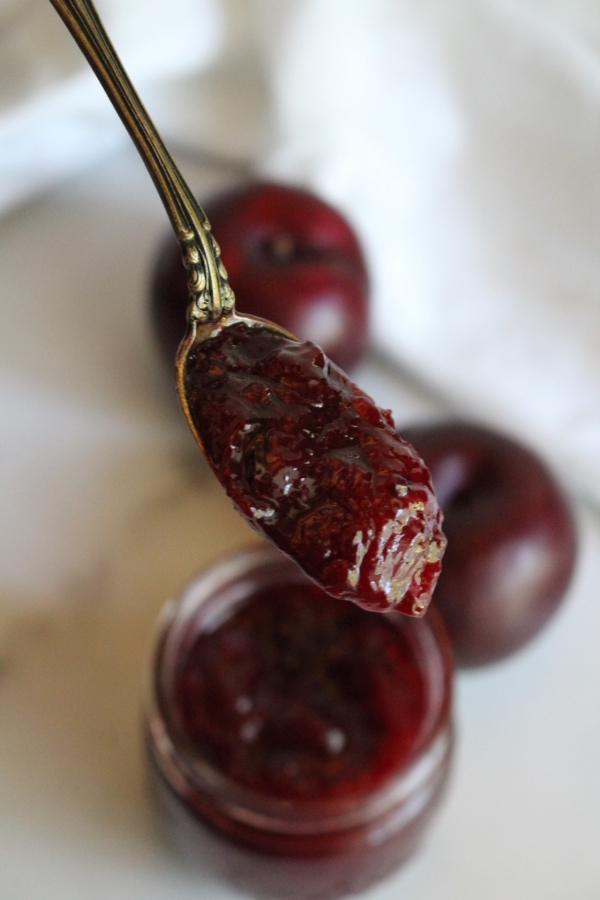
Place the plums and the sugar in a heavy-bottomed jam pot and bring the mixture to a boil over high heat. Be sure that you use a deep pot, and that the plums only come up about halfway up the sides to start.
The plum jam will foam up as it cooks, and if you fill the pot too much it’ll overflow. Stick to halfway full.
The plums will quickly release their juices when mixed with the sugar, so there’s no need to add liquid to get the cooking started. If you want, you can give it a splash of lemon juice, which will help bring out the fruit flavor by adding a bit of tart juice, but that’s completely optional (and I don’t).
While I add lemon juice to most of my jam recipes, I skip it with plum jam because I think they’re well balanced just the way they are (and they don’t need the extra acidity to really shine). Lemon juice also adds pectin, which helps jams gel, but again, plums don’t need it.
On high heat, it should take about 8-10 minutes for the plum mixture to come to a hard boil. Once it’s boiling hard, turn the heat down a bit to prevent scorching, and cook over medium to medium-high heat (stirring frequently to prevent scorching and overflows).
After about 30 minutes of total cook time, or 20 minutes at a hard boil, the jam should reach gel stage. This can vary a bit depending on your fruit, so keep an eye on it. Begin checking at 15 minutes, and know that it could take as long as 40-45 minutes to finish.
At first, it’ll look more or less like plum soup, with chunks of plums floating in a sea of juice. Once the plum jam gets near gel stage, the texture and the look of the bubbles in the pot will abruptly change. They’ll go from a frothy foam of tiny bubbles to glossy bubbles and the jam will noticeably thicken.
Experienced jam makers know what this looks like, and if you watch closely you can see it with your eye without other tests. It’s easier, however, to test for gel stage with an instant-read thermometer.
Jams “gel” at 220 degrees F at sea level, and that drops a bit at higher elevations. For every 500 feet above sea level the finish temperature will drop by 1 degree F. I’m at 1000 feet, so my jams finish at 218 F.
You can also test the texture of your jam by spooning a bit onto a plate that’s been chilled in the freezer. The plate will flash cool the jam, and you’ll be able to see if it’s gelled.
Once it’s reached gel stage, ladle the finished plum jam into prepared jars. This plum jam recipe should yield about 4 half-pint (8 oz) jam jars.
Plum Jam Variations
While sugar is the only strictly “necessary” ingredient to make plum jam, you can add other flavorings if you choose. Plums pair exceptionally well with vanilla, honey, and cinnamon in my opinion.
- Add the scraped seeds from a vanilla pod (or a few teaspoons of vanilla extract) into the jam once it’s reached gel stage. Stir it in and then pour into jars as usual. (Don’t cook the jam with vanilla in it, the flavor will all cook-off.)
- Substitute some or all of the sugar for honey for a rich, honey-flavored plum jam.
- Add 1-2 cinnamon sticks into the pot at the start, removing them as the jam finishes.
Though those are my favorite plum jam variations, my canning books have all manner of ideas too.
- Canning for a New Generation has one recipe for plum jam that incorporates rose water, and another that uses cardamom. Follow the instructions above for vanilla if using rosewater, and add cardamom as I describe cinnamon.
- Preserving with Pomona’s Pectin has a whole pile of plum jam recipes, and while you don’t actually need pectin of any sort to make the jam, it doesn’t mean they don’t have some great ideas. They suggest a basil/mint/plum jam, plum/ginger/orange, honeyed plum cardamom jam, and several others.
- Preserve It! has a unique plum and lime jam, as well as a plum and rum jam, both of which would be really different variations to try. They also have a plum wine recipe that’s lovely too!
Add whatever flavors you like, or stick with old-fashioned plum jam, the choice is yours. This recipe is pretty flexible and can accommodate a lot of flavor variations.
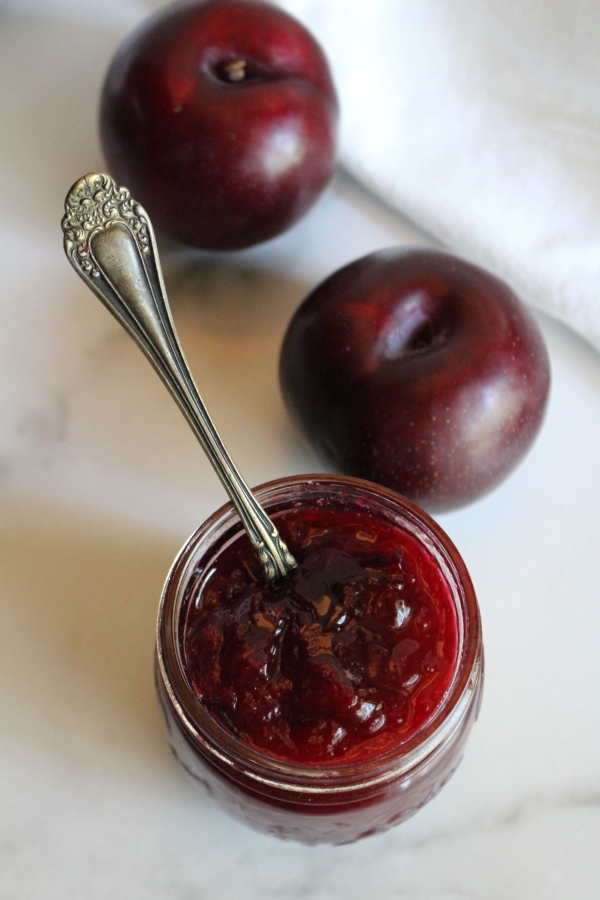
Canning Plum Jam
It’s perfectly fine to make this plum jam recipe without canning. Just make the jam, and be sure to store it in the refrigerator or freezer once it’s cooled. If it’s in the refrigerator, it’ll need to be used within a few weeks, while it’ll last up to 6 months in the freezer.
I’m personally a fan of canning because it saves on freezer space and allows me to take summer produce and make it shelf stable for year-round enjoyment.
To can plum jam, simply prepare a water bath canner before you begin. Once the jam reaches gel stage, ladle into canning jars leaving 1/4 inch headspace. Wipe rims, de-bubble jars and adjust the headspace to ensure it’s still 1/4 inch.
Cap with 2 part canning lids and process in a water bath canner for 5 minutes (pints and half pints). Adjust the time to 10 minutes if you’re above 1,000 feet in elevation, and to 15 minutes if you’re over 6,000 feet.
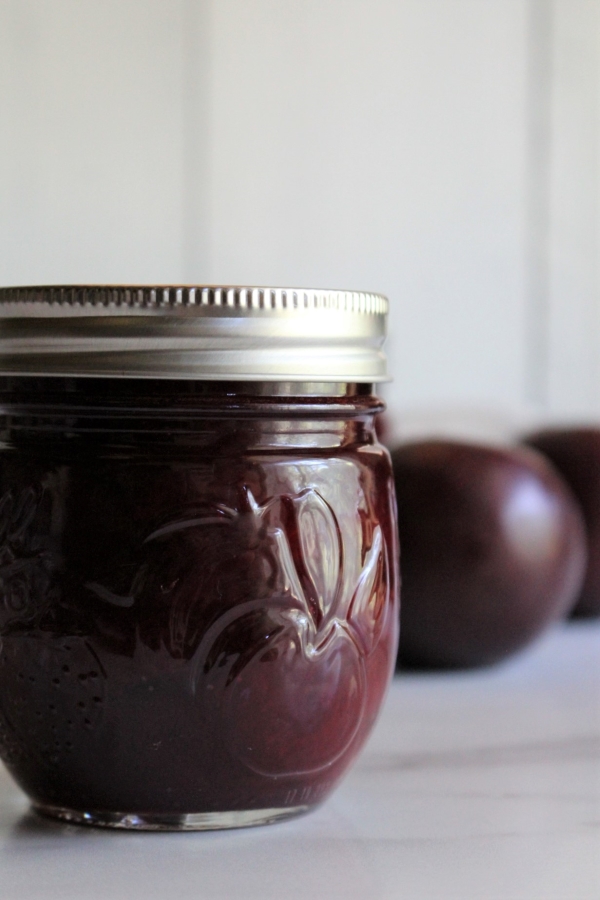 Ways to Preserve Plums
Ways to Preserve Plums
Looking for more tasty ways to preserve plums?
- Homemade Prunes
- Plum Butter
- Canning Whole Plums
- Freezing Plums
- Salt Brined Plums (Traditional Lacto-Fermented Plums)
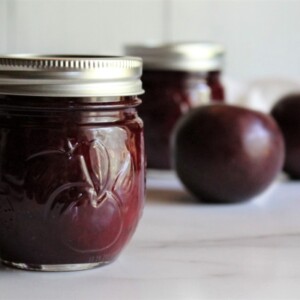
Plum Jam
Ingredients
- 9 cups chopped plums, 3 lbs prepared, from 3 1/2 lbs with pits
- 3 cups sugar, 1 1/2 lbs
Instructions
- Place the plums and sugar in a heavy-bottomed jam pot, ensuring that they fill it no more than halfway (the jam will foam up during cooking).
- Turn the heat to high and bring the mixture to a boil, stirring frequently to avoid scorching (8-10 minutes).
- Once the plum/sugar mixture is boiling hard, turn the heat down a bit to medium or medium-high to prevent scorching or overflows. Continue to stir frequently, and cook until the jam reaches gel stage. (That's 220 degrees when tested with an instant-read thermometer). It should take roughly 20 minutes at a boil, or 30 minutes total cook time, but can vary based on the fruit used.
- Once it reaches gel stage, ladle the mixture into prepared jars. Store in the refrigerator for immediate use, or freezer for up to 6 months. Or water bath can for long term storage.
- Optional Canning Instructions: If canning, ladle the finished plum jam into canning jars, leaving 1/4 inch headspace. Cap with 2 part canning lids and process in a water bath canner for 5 minutes (pints & half pints). Adjust canning time to 10 minutes if above 1000 ft in elevation, and to 15 minutes if above 6000 ft.
- Properly canned jam in sealed jars should last for 12-18 months at room temperature in the pantry without losing quality. Once opened, store in the refrigerator and use within a few weeks.
Notes
Summer Canning Recipes
Plums not the only thing you’re canning this summer? Try any of these easy canning recipes…
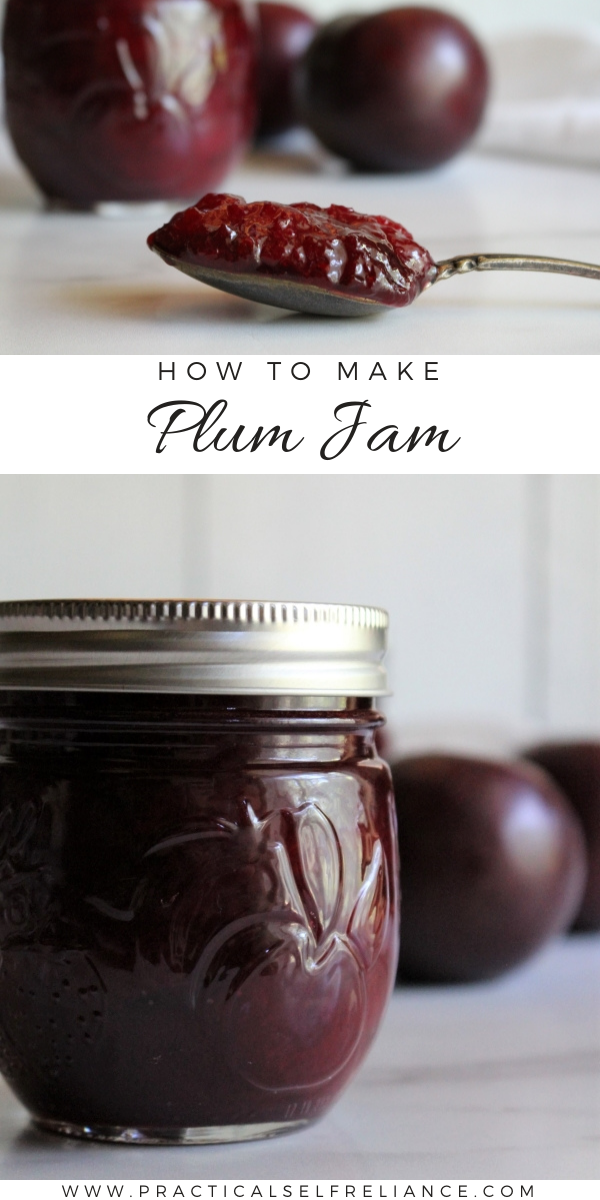

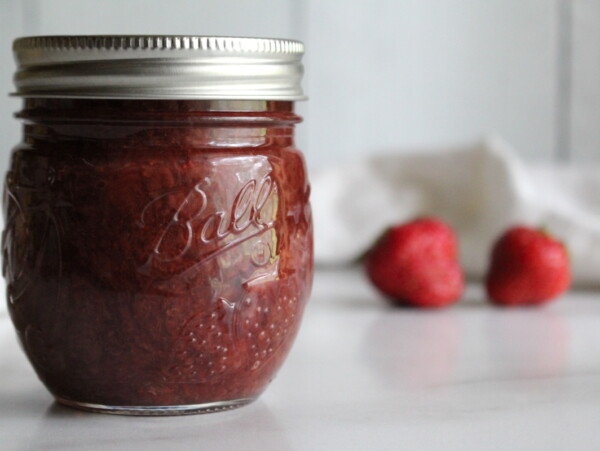


We have a diabetic in the family. I use sugar substitutes instead of regular sugar. Will this make a difference
You really need to use pectin if you aren’t using sugar in order to get the proper gel. You can use a product like Pomona’s Pectin with sugar substitutes. Just be sure that it is one that measures like sugar.
Would I be able to substitute the sugar for honey instead?
Yes, that’s fine. Enjoy!
Could I use honey instead of sugar for this recipe? Thanks!
Yes, that’s fine.
I followed this recipe but sadly my jam is more like a sauce. I had 9 cups of plums and 1 cup of sugar. Cooked until the glossy bit with no foam and then did the plate test. It seemed fine on the plate but I guess it froze because after 35 minutes of cooking and it thickening, this morning, it is just a jar of sauce. Can I pour it all back in the pan and cook more? How can I fix this?
It looks like you didn’t add the full amount of sugar which is very important to the gelling process. If you want to reduce the amount of sugar in the recipe you would want to add a low sugar pectin like Pomona’s Pectin.
Delicious! I added some dark rum and cardamom, so good! Thanks 🙂
You’re very welcome. So glad you enjoyed the recipe.
I made this and ended up with an extra pint. I cooked for 35minutes. Since I only had one cup of sugar, I used honey for the rest. Will that change the ability to gel or it’s shelf life? How long does it take for the jam to solidify after it is canned?
Tastes yummy! I hope it gets thicker as it sits on the shelf.
It could affect the ability to gel but it shouldn’t affect the safety or shelf life. It depends on the jam. You could pop it in the fridge. Sometimes that helps it to gel.
I had trouble getting the jam to gel. Admittedly I removed the skins, but you suggest above that should be fine too? But I did add lemon to one batch (cinnamon to another). At any rate, I started with more of a Greengage plum nectar and processed that at a simmer with the sugar for over an hour without it gelling very well on a frozen plate. So I added pectin in retroactively a half tablespoon at a time. Unfortunately I started getting gelatinous glops in my jam either from overcooking or pectin that would not mix, but the main mixture was not fully gelling for a while. The lemon mixture started to gel slightly first. I did see a glossy change in the texture even before fully gelling and eventually I got a decent gel with the lemon batch and a very light gel with the cinnamon batch, but I figured it would do and was tired of cooking! Any thoughts on what I did wrong!?
Removing the skins makes a big difference in the ability for it to gel since there is a large amount of pectin in the skin. Did you just put the pectin straight into the mixture? If so that’s probably what caused the clumping. You want to mix a quarter cup of sugar with 1 Tbsp of pectin before adding to the mixture.
How long do I process in the canner for quarts?
I’m not aware of a tested time for processing quart jars of jam. It’s probably because most people might not use the jam quickly enough after it has been opened before it goes bad.
Excellent recipe, so simple yet so good. I didn’t add lemon juice but I had some sparkling wine flavoring so I added that, perfect. And since I like it tart I only used 2 cups of sugar. Thank you, I will definitely make this again
You’re very welcome. We’re so glad you enjoyed the recipe.
Thank you so much for giving the amounts in volume and weight, especially the weight both whole and pitted for the plums! It makes it precise and so much easier to follow 🙂 Your site has not failed me, you’re always one of the best sources for good canning recipes.
Thank you! I’m so glad it’s helpful to you =)
I’ve been gifted buckets of prunes. Can I sub them for plums (I know prunes are plums but not all plums are prunes). I’ve also been gifted grapes. If I juice the grapes, can I sub grape juice for the sugar? What would be the ratio for grape juice to fruit?
“That results in a fruit to sugar ratio of 2:1 by weight or 3:1 ratio by volume.”
Thanks for your help. So excited to see a no pectin recipe!
The grape juice will most likely not have enough sugar in order to create a jam, especially without added pectin. The sugar is what causes the jam to gel. I have seen recipes for prune jam before, so you could probably do a quick internet search and find a recipe.
Hi Ashley,
I made this and canned two and a half pints from two grocery store bags of plums. It is so easy! And delicious.
Oleeta
That’s great! So glad you enjoyed the recipe.
What happens with the skins? Do they cook down and are they included in the final product?
They break apart in the final product somewhat, but they’re still in there. In my picture of the damson jam in the article, you can see a skin sitting right there on the spoon. In that batch, I just pitted the plums with a cherry pitter and then made the jam from the whole plums, so the skins are more noticeable. They add good texture/body to the finished jam in my opinion, and they’re barely noticeable I find. That said, you can minimize them in the jam by dicing your plums pretty small to start. The smaller the skin pieces at the beginning, the more likely they are to completely disintegrate or not be noticed at all in the jam. Even just slicing the plums into 1/8 slices around the plum I find they pretty much fall apart and you can’t really find them in the finished jam.
Thank you! The jam looks so good. This was a good picture year for us, so I will make your jam:).
You’re welcome. So glad you enjoyed the recipe.
This was so easy to make. I did add the dark rum. I also make my own vanilla, so I had a jar with the vanilla beans to use. So very good. I had an extra jelly jar of jam only half full that I used the Ball screw on lid to ‘test’ the morning after. Delicious.
My plums are very hard to get the pit out.
I’ve found that if I leave them in until they’re
Cooked down the seeds are easy to remove.
Is this an ok practice or will the pits alter the flavor.
Have you tasted the plums after cooking them down to see what they taste like? If the plums taste ok then your jam should be fine.
My mother always cooks seeds in especially small varieties. Strains out most, but leaves a few in.
I have bags of frozen, pitted plums from last summer. Will those work just as well?
Probably…but it might not set quite as well. Freezing reduces the pectin in fruits. For jam, they’re probably still ok so long as you leave the skins in (since they’re the highest in pectin), but I wouldn’t try making jelly where you strain out the solids. Good luck and let me know how it goes!